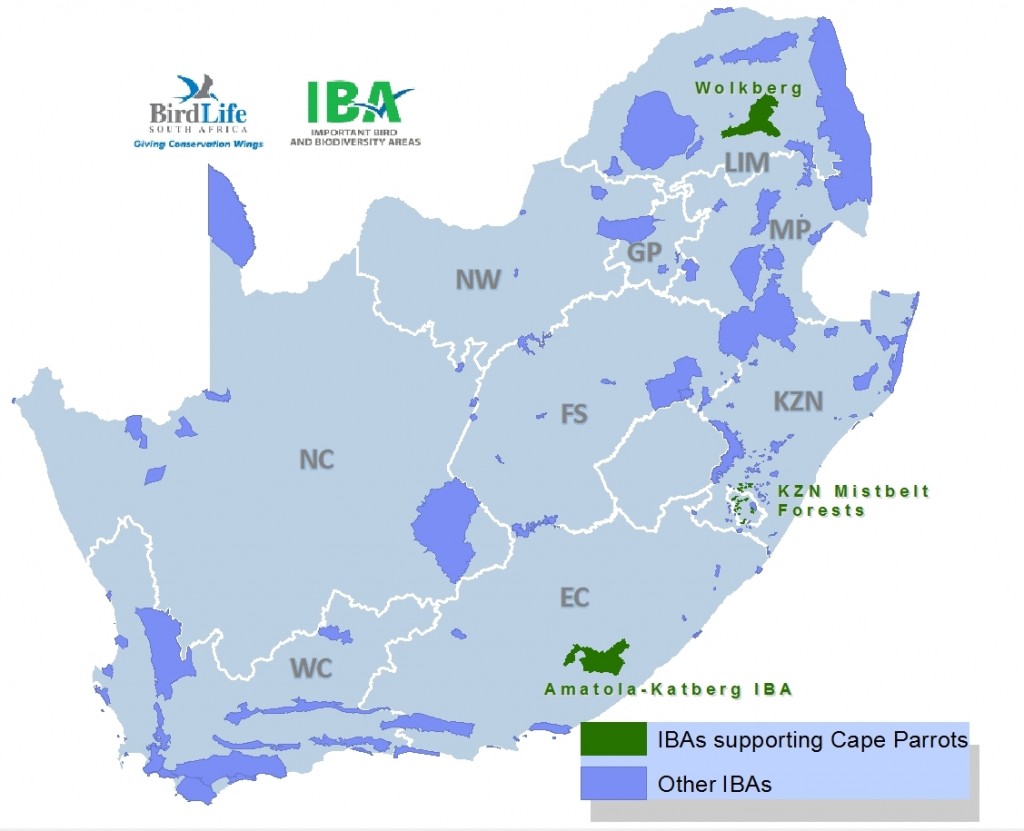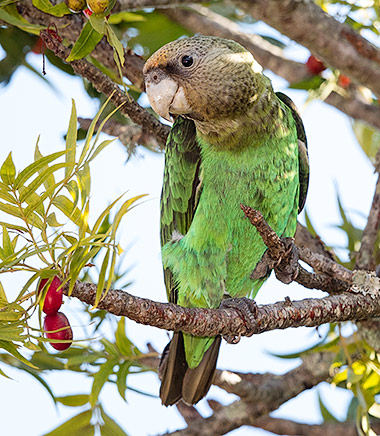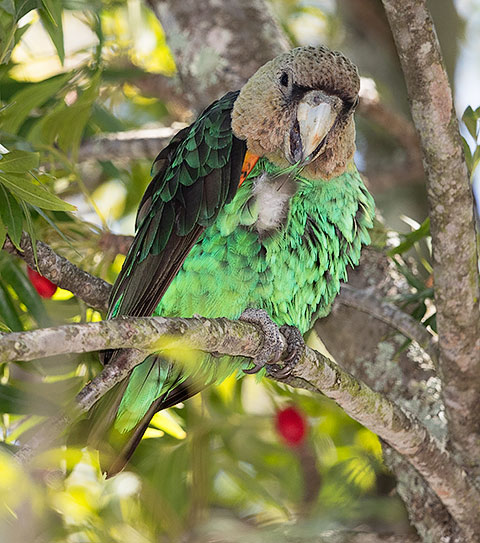Cape Parrots 2

Carry this bag to show your support!
As part of their Good Business Journey, Woolworths is proud to support initiatives like BirdLife South Africa’s Important Bird and Biodiversity Areas Programme. Through partnerships with their customers and organisations like BirdLife South Africa, Woolworths is increasing awareness of environmental issues and the importance of conservation, while actively supporting BirdLife South Africa’s projects. Through the sale of each bag, Woolworths donates R10 to BirdLife South Africa.

Photo Credit: Warwick Tarboton
WHO IS BIRDLIFE SOUTH AFRICA?
BirdLife South Africa is a registered non-profit and public benefit environmental organisation’s vision is to see a country and region where nature and people live in greater harmony, more equitably and sustainably.
Important Bird and Biodiversity Areas Programme (IBA)
The Important Bird and Biodiversity Areas (IBA) Programme is one of BirdLife South Africa’s most important conservation programmes. It speaks to all four focal areas of BirdLife South Africa – species, sites, habitats and people. It identifies and works to conserve a network of sites and habitats across South Africa critical for the long-term survival of bird species that:
• are globally threatened
• have a restricted range
• are restricted to specific biomes/vegetation types
The purpose of the IBA Programme is to identify and protect a network of sites, at a biogeographical scale, critical for the long-term viability of naturally-occurring bird populations. The IBA Programme helps to prioritise conservation action amongst sites. BirdLife South Africa is at the forefront of improving management of habitats and securing the protection of key sites within IBAs. The IBA Programme is leading on aspects of Biodiversity Stewardship (private land conservation and protection) work in South Africa, having now partnered in declaring almost 200 000 hectares as protected areas.
WHAT PROJECT WILL THE FUNDS SUPPORT?
The funds raised through this initiative will go towards helping to protect and secure some of the last remaining habitat of the Cape Parrot (Poicephalus robustus robustus). The Cape Parrot is listed as Endangered as they are habitat specialists, dependent on mature Afromontane Yellowwood (Podocarpus) forest (at 1000-1700 m.a.s.l.) for most of their diet and nesting sites.0 masl).

Photo Credit: Warwick Tarboton
Today, less than 2% of all South African landscapes comprise of natural forest and only a small proportion of those are Afromontane Yellowwood forests. Habitat fragmentation and loss continue through legal and illegal extraction of yellowwoods from these forests, further fragmenting the Cape Parrot’s already disjointed habitat.
For this reason the species is a priority trigger species for identifying IBAs. The core of the Cape Parrot population (where the most critical habitat remains) is represented by three IBAs namely the Wolkberg Forest Belt in Limpopo, the KwaZulu-Natal Mistbelt Forest in KwaZulu-Natal, and the Amatola-Katberg Mountain in the Eastern Cape. BirdLife South Africa is currently beginning the process of attempting to get the Amatola-Katberg Mountain IBA expanded. The biggest challenge facing the conservation of the species is the need to protect the forest habitat on which they so closely rely, made difficult by a history of over-utilisation, degradation and consequent fragmentation which continues to this day. Mortality from psittacine beak and feather disease (PBFD) is also an increasingly common concern.

Annual Cape Parrot Big Birding Day
The annual Cape Parrot count is in its 25th year! The Cape Parrot Big Birding Day (CPBBD) was initiated in 1998 by the Cape Parrot Working Group based at the University of KwaZulu-Natal and has been held annually since. The Cape Parrot is a flagship species for South Africa’s Afromontane/-temperate indigenous forest patches and their surrounding grasslands. The present Cape Parrot population consists of three subpopulations, the southern group in the Amatole’s in the Eastern Cape, the central group from Ncogbo and Mthatha in the Eastern Cape through to the Midlands in KwaZulu-Natal, and a disjunct northern group mainly in the Magoeboeskloof, Limpopo Province. Standard bird counting techniques are unsuitable for Cape Parrots as their cryptic colouration combined with dense forest habitats often makes them difficult to locate once perched, but their loud, harsh calls whilst in-flight make them conspicuous. They are most active during the first few hours after dawn and before sunset when they leave and return to their roosts in forest patches, although these periods can be extended during misty conditions. These characteristics allow for a ‘total count’ of the parrots. The count relies heavily on volunteers so please consider joining (Contact Prof CT Downs email: downs@ukzn.ac.za; Cell: 0829202026 or See: https://cpwg.ukzn.ac.za/).
International Ornithological Congress 2022 Durban, South Africa
The International Ornithological Congress (IOCongress2022) will be hosted in South Africa from the 14th to the 20th of August 2022. South Africa’s only endemic parrot, the Cape Parrot, was chosen to be the symbol of the congress and was drawn by artist Nicky Kirby. The conference was originally planned to be a hybrid event, being hosted in Durban, but because of the uncertainty of the COVID-19 pandemic, it was decided that a fully virtual event would be the best option. A virtual congress will look and feel different from one in person, but this virtual attendance will offer multiple ways to engage, explore, network, and socialise. The organisers of the congress plan to make the event as accessible as possible not only to students and early career researchers, but to the local birding community as well. This will be achieved by the availability of virtual passes for certain talks and symposia. The virtual platform will be available to all registered attendees for the duration of the congress as well as post-congress. All live sessions will be recorded and available to watch on-demand. Please visit www.iocongress2022.com for more information and follow the social media channels for updates and interesting content.
HOW WILL THE CAPE PARROT BAG ASSIST US ?
Funds raised will be used to help safeguard remaining patches of Cape Parrot habitat and ensure that these fragmented patches are secured. Funds will also go towards supporting next year’s Cape Parrot Counting Day, which is an annual census event held to gain information on the current population of Cape Parrots in South Africa.
Photo Credit: Warwick Tarboton
Who are the principle people in the organisation, who will be directly involved in the implementation of the funds?
Mark Anderson (CEO of BirdLife South Africa)
Dr Melissa Whitecross (Landscape Conservation Programme Manager)
When was the project be initiated?
The IBA Programme commenced in 2009 and is an ongoing programme. The goal is to continually increase the level of protection given to land identified within IBAs, to protect the species that rely on them.

 Bags 4 Good
Bags 4 Good
